Hello fellow readers; Sara from Oxford, NJ, asked how to prepare a plot for starting an organic garden. She suspects the previous owners used chemicals, as when they moved in, the lawn “looked like a golf course.” Kudos Sara. It’s wise to consider the prior use of chemicals, particularly when growing food.
I always recommend a soil test first, no matter what garden you plan. Soil tests done by local extension offices will assess soil nutrients, pH, and physical characteristics. However, identifying chemical contaminants requires specialized testing. Other countries are ahead of ours in the concern of chemicals in food production. Hence, labs overseas often test for over 400 pesticide residues.
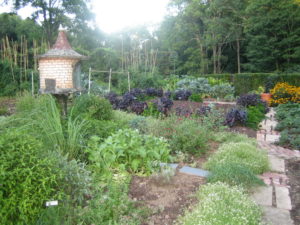
My friend and design colleague Marty Carson’s (Three Seasons) organic garden work of art!
When soil testing for chemicals is wise.
When you arrange soil testing with your extension office, ask if they can refer you to a local certified lab for chemical testing, especially if you live in an urban area where manufacturing exists or once did. Or if you live in an older home that may have once had lead paint.
Based on Sara’s description of a golf course lawn, it’s likely best to install raised beds using chemical-free borders such as rocks or natural lumber —not chemically preserved pressure-treated lumber used in decks. Then fill your raised beds with organic soil and compost. You could also consider container gardening or grow bags, a hot new trend.
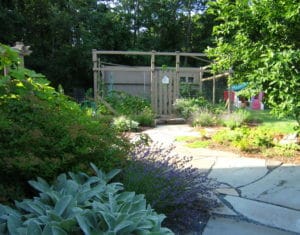
A vegetable garden can be lovely next to your patio, as with my client Jacquie’s garden.
While buying vegetable plants at a local grower a few years back, I ran into a fellow who had an interesting way to test to see if his compost or soil was affected by chemical herbicides.
Home Test for Soil Contaminants
Robert is a self-described “amateur farmer,” though his knowledge of organic practices is beyond novice. He and his wife farm about an acre of produce and organic eggs. Buckhorn Creek Farm is the “unofficial name” of their farm in White Township. Robert advised recent chemical introductions with more prolonged residual effects may impact large-scale organic soil and compost operations. In other words, chemicals can leach despite the best efforts by suppliers offering organic compost and soil. He shared that pea seeds, sensitive to chemicals, can be used in a home test.
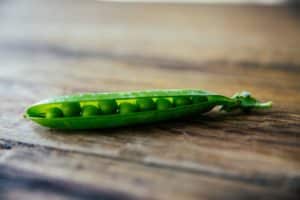
Photo by Rachael Gorjestani on Unsplash
Roll ten seeds in a damp paper towel and place them in a plastic bag. Then plant ten seeds in your moist compost or soil to be tested. Place both in a warm spot; no need for sun. In two to five days, check germination. If the same number of seeds, typically eight or nine, germinate in the paper towel and the soil, you should be good to go. If fewer seeds sprout in the soil or compost, there is likely a problem of contaminants.
A fun DIY pH Test you can do.
And while you’re at it, There’s a fun DIY pH test you can do too. Put two teaspoons of soil into two separate containers. Add ½ cup of white vinegar to the soil in one container. If it fizzes, your soil is alkaline. If there is no fizz, add enough distilled water to the other container to muddy it. Pour ½ cup of baking soda into that cup; if it fizzes, your soil is acidic. If neither sample fizzes, you likely have neutral pH. Most plants and lawns love neutral.
Some naysayers claim vinegar and baking soda are not strong enough to give an accurate result. But I say, why not have some fun before reaching out to your extension office? That way, you can compare the results and maybe poo-poo the naysayers. What is fun it is fun to be a big kid—highly recommended. :^)
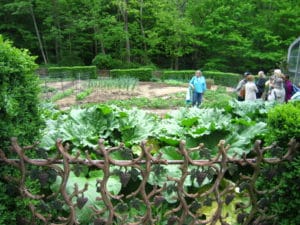
Organic Vegetable Gardens are Works of Art
Back to preparing raised beds—While vegetables vary in how deep their roots grow, twelve inches is an excellent standard depth for raised beds. Robert mentioned using COR-TEN (weathering steel) as a raised bed border. It’s the same steel developed for the railroad industry and used in garden art—only the outer level rusts, which would make a strikingly rustic garden edge. Organic vegetable gardens are indeed works of art!
Garden Dilemmas? AskMaryStone@gmail.com and your favorite Podcast App.
There’s more to the story in the Garden Dilemmas Podcast:
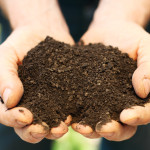 Link to Vegetable Gardening Basics and Starting a No-Till Garden
Link to Vegetable Gardening Basics and Starting a No-Till Garden
Other Fun Ways to Test Soil pH
Link to Cornell Soil Health Laboratory


